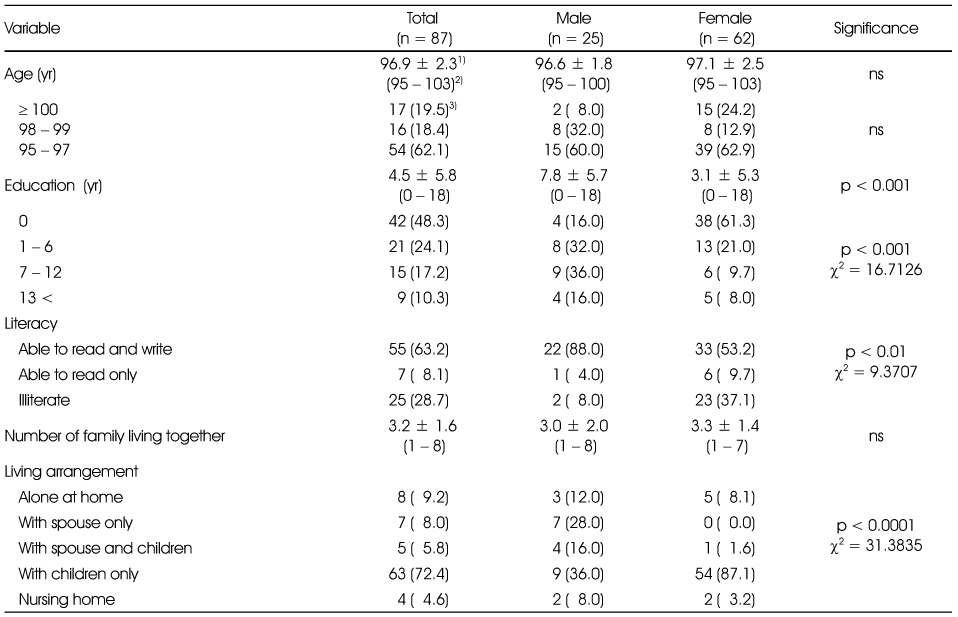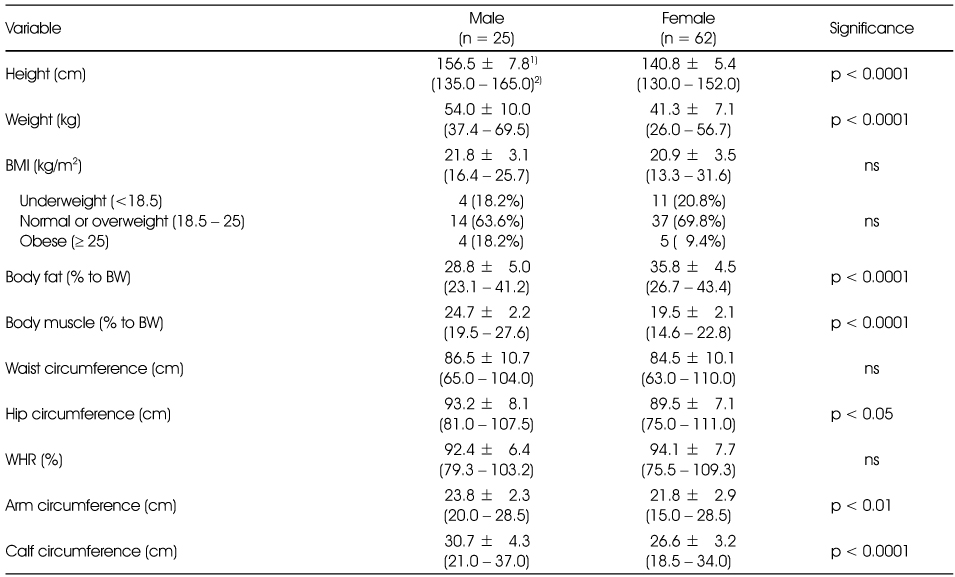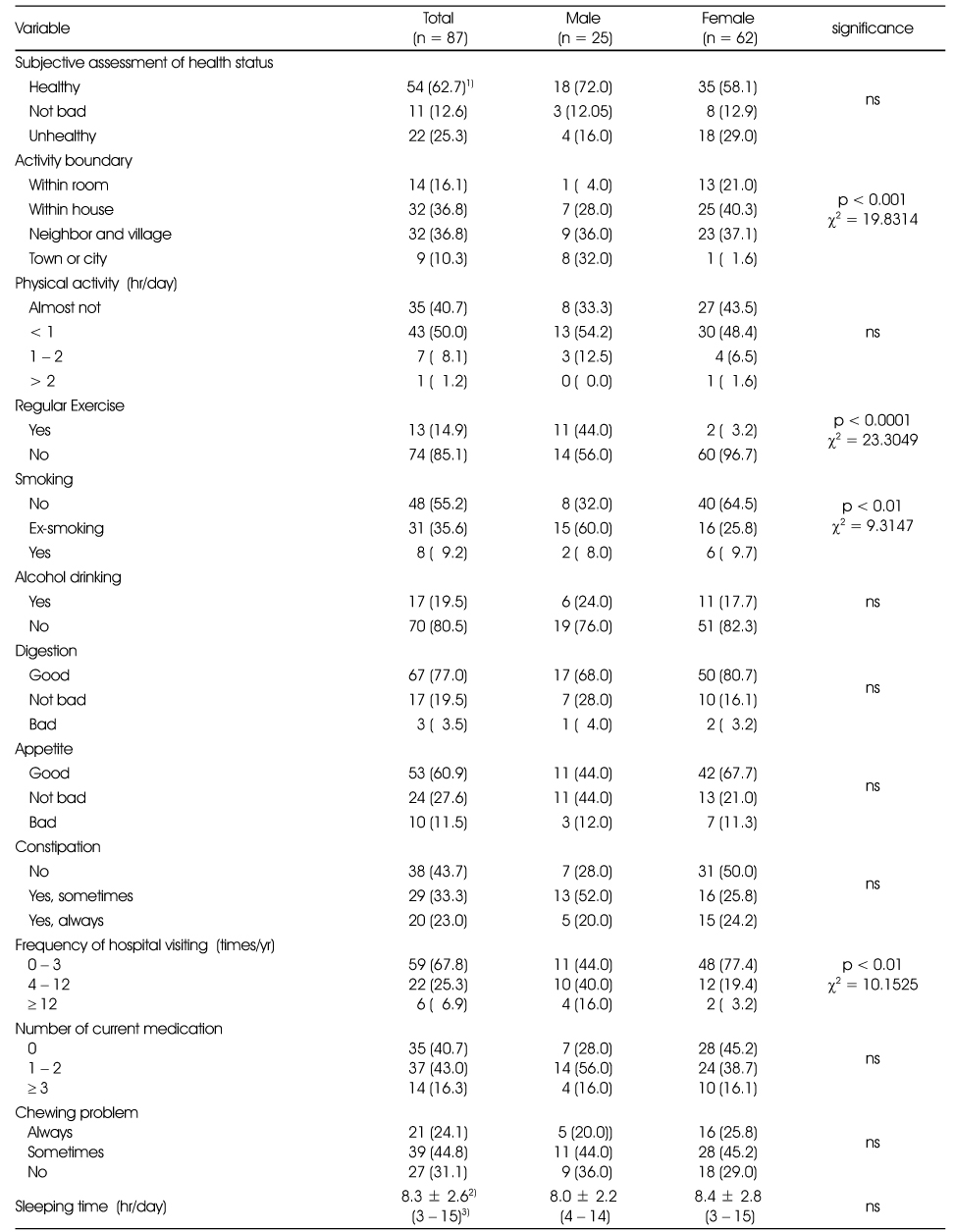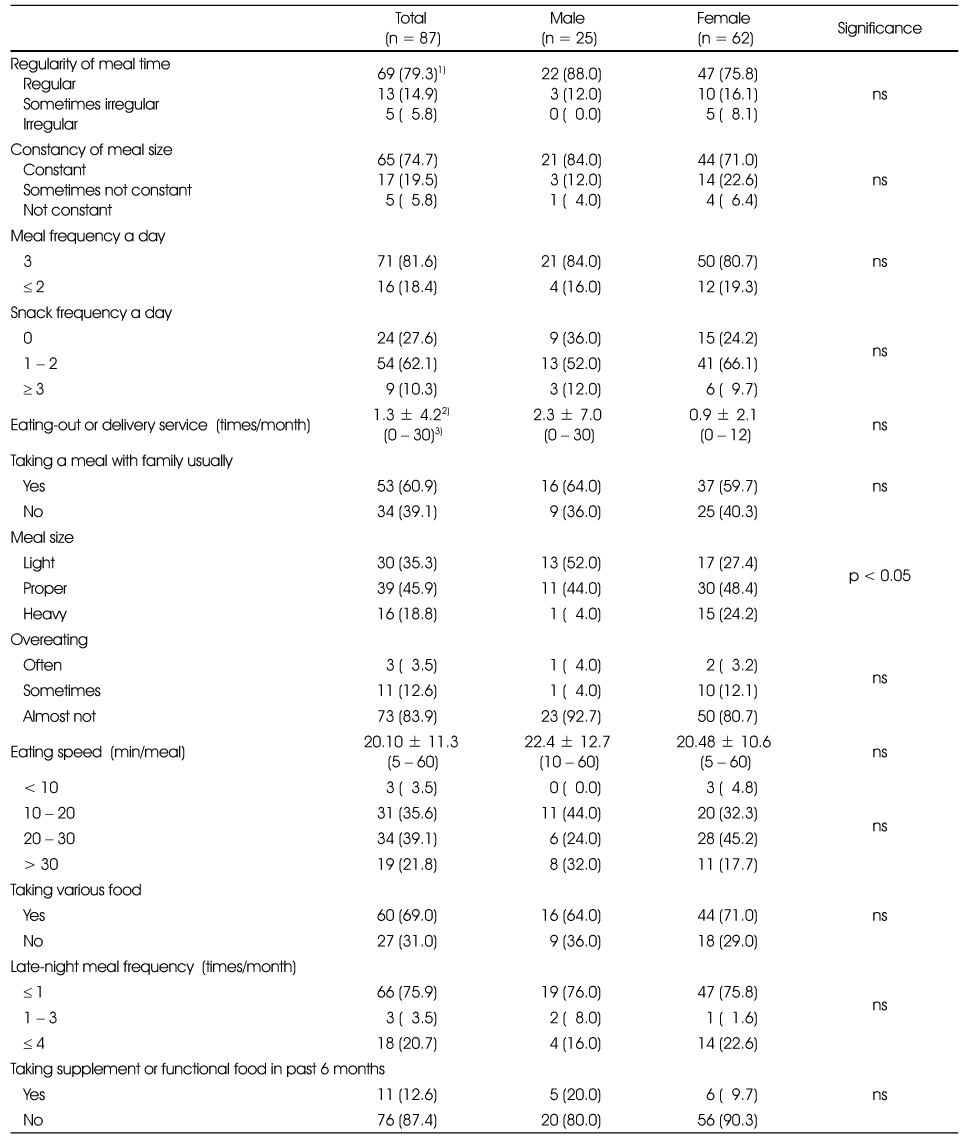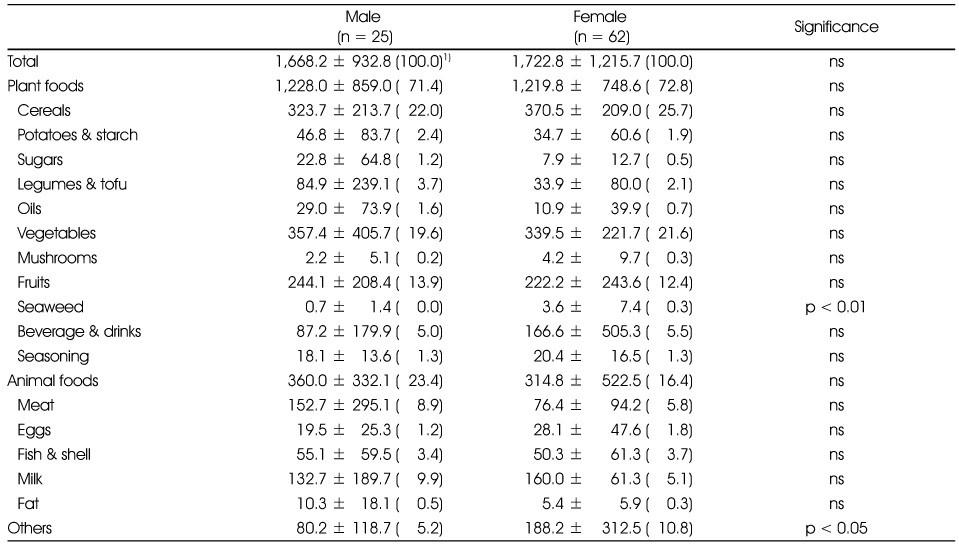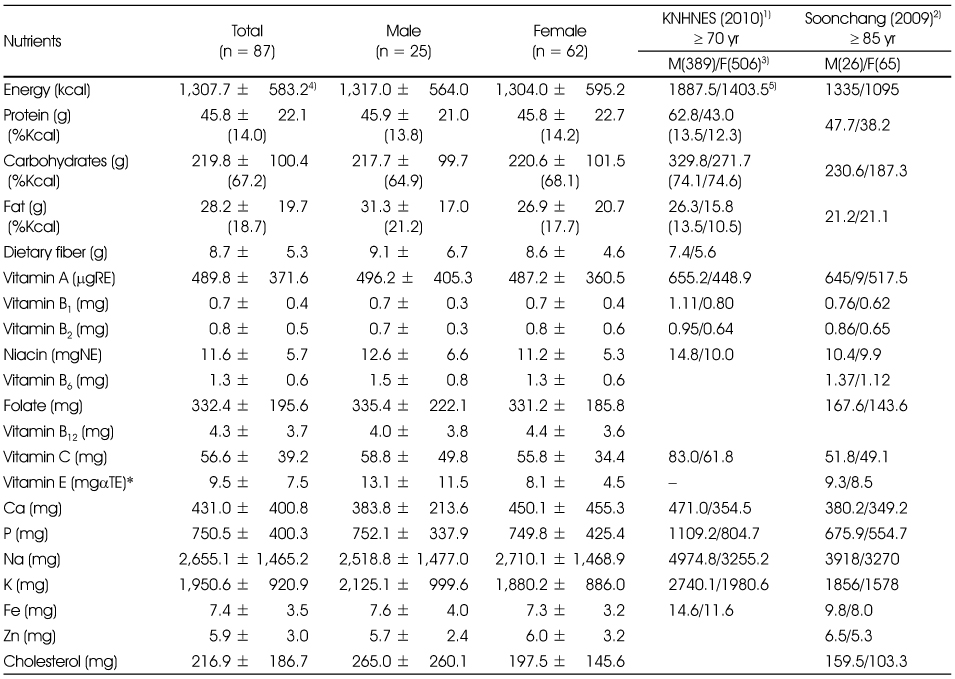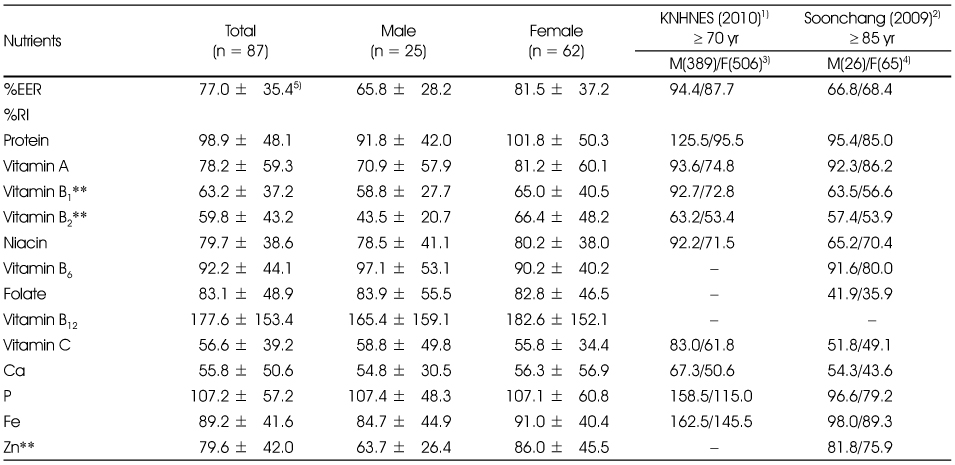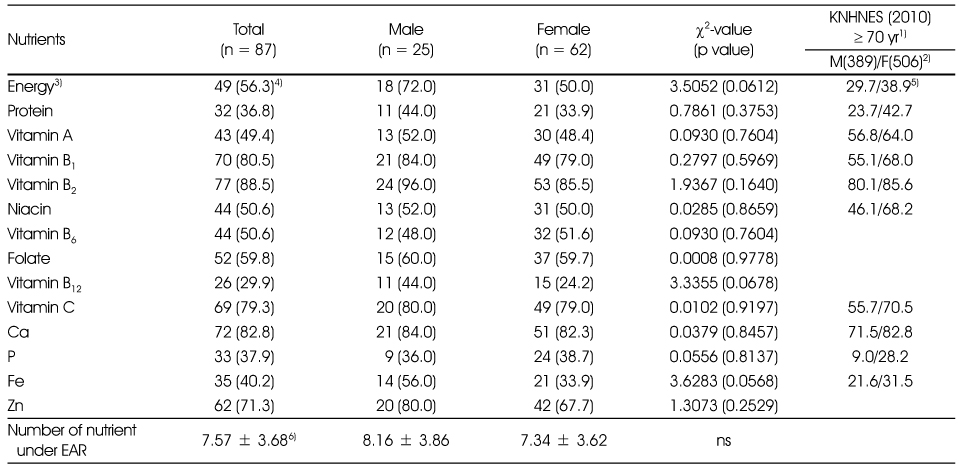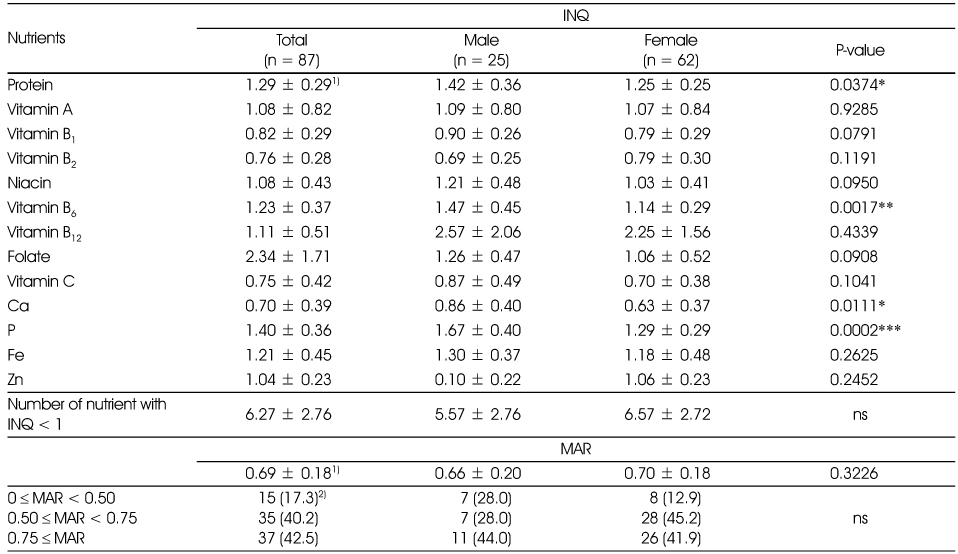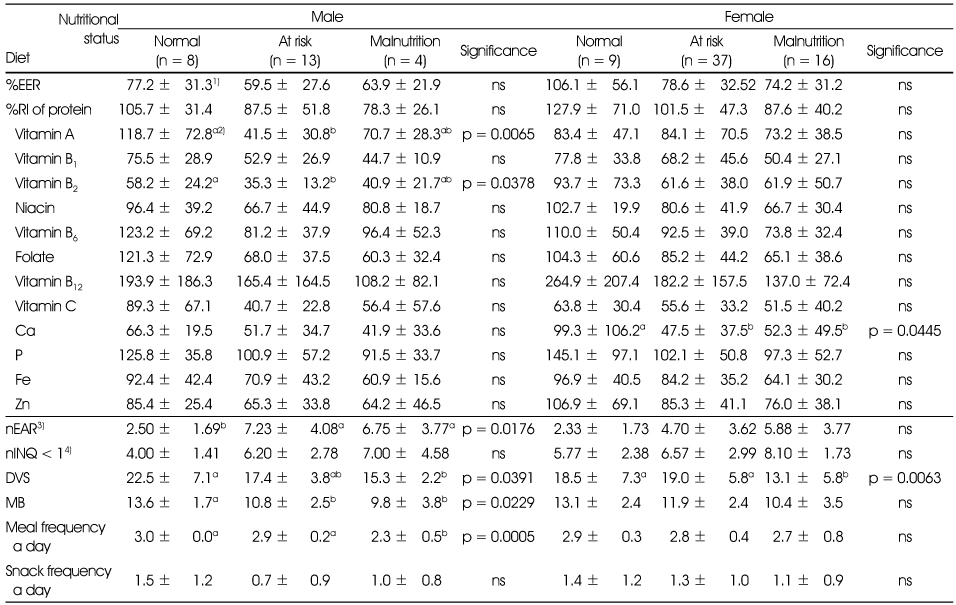References
1. Allard JP, Aghdassi E, McArthue M. Nutrition risk factors for survival in the elderly living in Canadian long-term care facilities. J Am Geriatr Soc 2004. 5259–65.
2. Amador LF, Al Snih S, Markides KS, Goodwin JS. Weight change and mortality among older Mexican Americans. Aging Clin Exp Res 2006. 18(3)196–204.
3. Arai Y, Hirose N, Nakazawa S, Yamamura K, Shimizu K, Takayama M, Ebihara Y, Osono Y, Homma S. Lipoprotein metabolism in Japanese centenarians : effects of apolipoprotein E polymorphism and nutritional status. J Am Geriatr Soc 2001. 491434–1441.
4. Baek JW, Koo BK, Kim KJ, Lee YK, Lee SK, Lee HS. Nutritional status of the long-lived elderly people in Kyungpook Sung-Ju area(I)-Estimation of nutrient intakes. Korean J Nutr 2000. 33(4)438–445.
5. Chan YC, Suzuki M, Yamamoto S. Dietary, anthropometric, hematological and biochemical assessment of the nutritional status of centenarians and elderly people in Okinawa, Japan. J Am Coll Nutr 1997. 16229–235.
6. Choe JS, Baek HY, Kwon SO. Nutritional status and related factors of residents aged over 50 in longevity areas -I. Anthropometric and biochemical nutritional status. Korean J Nutr 2004. 37(9)825–837.
7. Choe JS, Kwon SO, Paik HY. Nutritional status and related factors of residents aged over 50 in longevity areas -II. Effect of dietary factors on bone ultrasound measurements in aged men. Korean J Nutr 2006. 39(2)171–183.
8. Choi JH, Kim MH, Cho MS, Lee HS, Kim WY. The nutritional status and dietary pattern by BMI in Korean elderly. Korean J Nutr 2002. 35(4)480–488.
9. Choi JH, Kim MH, Cho MS, Lee HS, Kim WY. The nutritional status and dietary pattern by BMI in Korean elderly. Korean J Nutr 2002. 35(4)480–488.
10. Ennis BW, Saffel-Shrier S, Verson H. Diagnosis malnutrition in the elderly. Nurse Pract 2001. 26(3)52–56.
61–62.
65.
11. Gaudreau P, Morais JA, Shatenstein B, Gray-Donald K, Khalil A, Dionne I, Ferland G, Flp T, Jacques D, Kergoat MJ, Tessier D, Wagner R, Payette H. Nutrition as a determinant of successful aging: description of the Quebec longitudinal study nuage and results from cross-sectional pilot studies. Rejuvenation Res 2007. 10(3)377–386.
12. Gondo Y, Hirose N, Arai Y, Inagaki H, Masui Y, Yamamura K, Shimizu K, Takayama M, Ebihara Y, Nakazawa S, Kitagawa K. Functional status of centenarians in Tokyo, Japan: developing better phenotypes of exceptional longevity. J Gerontol A Biol Sci Med Sci 2006. 61(3)305–310.
13. Guerin O, Soto ME, Brocker P, Robert PH, Benoit M, Vellas B. Nutritional status assessment during Alzhemier's disease: results after one year. J Nutr Health Aging 2005. 981–84.
14. Guigoz Y. The mini-nutrition assessment (MNA) review of the literlature-What dose it tell us? J Nutr Health Aging 2006. 10(6)466–485.
15. Guthrie HA, Scheer JC. Validity of a dietary score for assessing nutrient adequacy. J Am Diet Assoc 1981. 78240–245.
16. Hansen RG. An index of food quality. Nutr Rev 1973. 31(1)1–7.
17. Hansen RG, Wyse BW. Expression of nutrient allowances per 1,000 kcal. J Am Diet Assoc 1980. 76(3)223–227.
18. Hausman DB, Fischer JG, Johnson MA. Nutrition in centenarians. Maturitas 2011. 68203–209.
19. Hwang JY, Ru SY, Ryu HK, Park HJ, Kim WY. Socioeconomic factors relating to obesity and inadequate nutrient intake in women in low income families residing in Seoul. Korean J Nutr 2009. 42(2)171–182.
20. KCDCP, Korea Center for Disease Control and Prevention. 2009 National Health Statistics-Korea national health and nutrition examination survey 2010. retrieved Jul. 5, 2012. from
http://knhanes.cdc.go.kr.
21. KCDCP, Korea Center for Disease Control and Prevention. 2010 National Health Statistics-Korea national health and nutrition examination survey 2011. retrieved Jul. 23, 2012. from
http://knhanes.cdc.go.kr.
22. Keller HH, Østbye T, Goy R. Nutritional risk predicts quality of life in elderly community-dwelling Canadians. J Gerontol A Biol Sci Med Sci 2004. 5968–74.
23. Kim YK, Lee HO, Chang R, Choue R. A study on food habits, nutrient intake and the disease distribution in the elderly (aged over 65 years) (I). Korean J Community Nutr 2002. 7(4)516–526.
24. Korean Nutrition Society. Dietary reference intakes for Koreans 2010. First revisionth ed. Seoul: Hanarum publishing;
25. Krebs-Smith SM, Wright HS, Guthrie HA, Krebs-Smith J. The effects of variety in food choices on dietary quality. J Am Diet Assoc 1987. 87(7)897–903.
26. Kwak CS, Yon M, Lee MS, Oh SI, Park SC. Comparison of anthropometric index and nutrient intake in Korean aged 50 plus years living in longevity-belt region. Korean J Community Nutr 2010. 15(3)308–328.
27. Kwon IS, Kim CH, Ko HS, Cho SI, Choi YH, Park SC. Risk factors of cardiovascular disease in Korean exceptional longevity. J Korean Geriatr Soc 2005. 9(4)251–265.
28. Kwon IS, Park SC. Gender-specific and age-dependent changes in health status and medical characteristics of Korean centenarians. Korean J Gerontol 2005. 15(3)10–25.
29. Lee MS. Nutritional status of the nanogerian population in longevity belt in Korea. Korean J Community Nutr 2005. 10(3)290–302.
30. Lee MS. Nutritional status of the oldest-elderly population in Soonchang county. Korean J Community Nutr 2009. 14(3)255–265.
31. Lee MS, Eui EJ, Kwak CS, Kim K, Choi YH, Kwon IS, Kim CH, Park SC. Gender difference in health and nutritional status of Korean centenarians. Korean J Gerontol 2005. 15(3)65–75.
32. Lim YJ, Choi YS. Dietary behaviors and seasonal diversity of food intakes od elderly women living as compared to those living with family in Gyeongbuk rural area. Korean J Community Nutr 2008. 13(5)620–629.
33. Yim KS, Lee TY. Socioedemographie factors associated with nutrients intake of elderly in Korea. Korean J Nutr 2004. 37(3)210–222.
34. Newman AB, Yanez D, Harris T, Duxbury A, Enright PL, Fried LP. Weight change in old age and its association with mortality. J Am Geriatr Soc 2001. 49(10)1309–1318.
35. Ozaki A, Uchiyama M, Tagaya H, Ohida T, Ogihara R. The Japanese centenarians study : Autonomy was associated with health practices as well as physical status. J Am Geriatr Soc 2007. 5595–101.
36. Park MY, Kim GR, Lee DJ, Kim JM, Park PS. A survey of food and nutrient intakes of the aged people in rural area, Gyeongbook Yecheon. Korean J Nutr 2006. 39(1)58–73.
37. Park SC. Korean centenarians 2002. Seoul: Seoul National University Press;
38. Park SC, Lee JJ, Park SO, Han KH, Lee MS, Kwon IS. Report of the study on characteristics of long-lived population in Kangwon province 2004. Seoul National University;
39. Park SC, Lee MS, Kwon IS, Kwak CS, Yeo EJ. Environment and gender influences on the nutritional and health status of Korean centenarians. Asian J Gerontol Geriatr 2008. 3(2)75–83.
40. Shimizu K, Takeda S, Noji H, Hirose N, Ebihara Y, Arai Y, Hamamatsu M, Nakazawa S, Gondo Y, Konishi K. Dietary patterns and further survival in Japanese centenarians. J Nutr Sci Vitaminol 2003. 49(2)133–138.
41. Somes GW, Kritchevsky SB, Shorr RI, Pahor M, Applegate WB. Body mass index, weight change and death in older adults: the systolic hypertention in the elderly program. Am J Epidemiol 2002. 156132–138.
42. Sorenson AW, Wyse BW, Wittwer AJ, Hansen RG. An index of nutritional quality for a balanced diet. New help for an old problem. J Am Diet Assoc 1976. 68(3)236–242.
44. Takeda S, Noji H, Hirose N, Arai Y, Yamamura K, Shimizu K, Homma S, Ebihara Y, Takayama M. Nutritional intake by the oldest elderly Japanese. Tokyo Centenarian Study 6. Nippon Ronen Igakkai Zasshi 1998. 35(7)548–558.
45. Thomas DR, Ashmen W, Morley JE, Evans WJ. Nutritional management in long-term care: development of a clinical guideline. Council for nutritional strategies in long-term care. J Gerontol A Biol Sci Med Sci 2000. 55(12)M725–M734.
46. Vellas B, Guigoz Y, Baumgartner M, Garry PJ, Lauque S, Albarede JL. Relationships between nutritional markers and the mini-nutritional assessment in 155 older persons. J Am Geriatr Soc 2000. 48(10)1300–1309.
47. Vellas B, Lauque S, Gillette-Guyonnet S, Andrieu S, Cortes F, Nourhashmi F, Cantet C, Ousset PJ, Grandjean H. The REAL FR group. Impact of nutritional status on the evolution of Alzheimer's disease and on response to acetylcholinesterase inhibitor treatment. J Nutr Health Aging 2005. 975–80.
48. Vellas B, Villars H, Abellan G, Soto ME, Rolland Y, Guigoz Y, Morley JE, Chumlea W, Salva A, Rubenstein LZ, Garry P. Overview of the MNA - Its history and challenges. J Nutr Health Aging 2006. 10(6)456–465.
49. Yang EJ, Bang HM. Nutritional status and health risks of low income elderly women in Gwangju area. Korean J Nutr 2008. 41(1)65–76.
